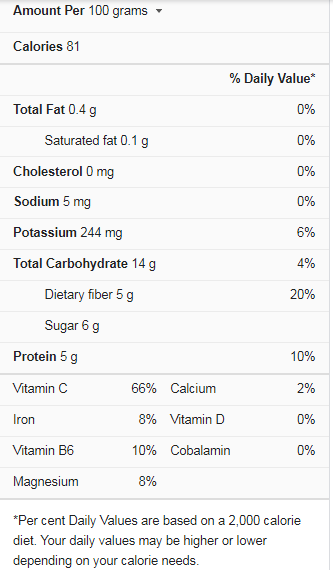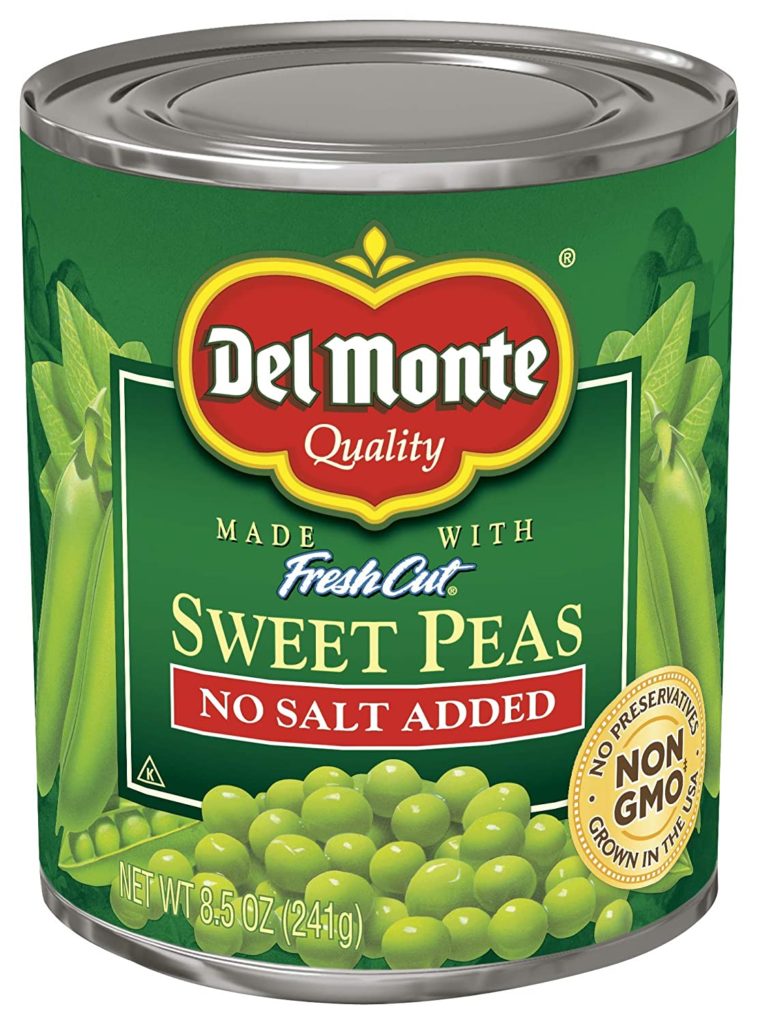Green peas, often known as garden peas, grow inside green, spherical pods. The sweet and starchy peas within are delicious. Snow peas and snap peas are sweeter than garden peas because they grow inside edible pods. Peas belong to the Fabaceae plant family, the bean or pulse family. Peas are produced worldwide now, despite their origins in Asia and the Middle East. Believe me again, if you think peas are just ordinary vegetables.
These tiny bead-sized diamonds pack a powerful punch for nutrition and health benefits. Peas belong to the legume family of foods, and plants that produce pods with seeds or beans are called legumes. Lentils, soybeans, chickpeas, and various beans are legume foods.
Green Peas Nutrition Facts
Green Peas’ Health Benefits
Peas include a high concentration of vitamins, minerals, antioxidants, and phytonutrients, which give vital health advantages ranging from eye health to cancer prevention.
Eye Health
The carotenoids lutein and zeaxanthin are found in peas and these nutrients aid in preventing chronic eye illnesses such as cataracts and age-related macular degeneration. Lutein and zeaxanthin are antioxidants that protect the eyes from damaging blue light, which causes cataracts and macular degeneration.
Digestive Health
Peas include a vitamin called coumestrol, which helps to prevent stomach cancer. A study conducted in Mexico City in 2009 found that eating peas and other legumes regularly reduced the incidence of stomach cancer by 50%. Peas are also abundant in fiber, which aids digestion by moving food through the gut.
They are High in Nutrients and Antioxidants
Every bite of green peas is packed with nutrients! After all, it’s high in protein, vitamins, minerals, and carbohydrates. Oh, and did we mention how low in calories they are? If there’s one thing that sets them apart from other foods, it’s the amount of protein they contain. They’re also high in antioxidants, which benefit your health!
They Regulate your Blood Sugar Levels
Today’s packaged foods are loaded with hidden sweets, and before we know it, our blood sugar levels have skyrocketed. On the other hand, Peas can be pretty beneficial to your health. To begin with, they have a low glycemic index, which means they do not immediately spike your blood sugar levels. They’re also high in fiber and protein, which can help control blood sugar levels. Research shows that consuming certain protein-rich foods can help patients with type 2 diabetes lower their blood sugar levels.
They Help with Digestion
Green peas, as previously said, are high in fiber, which is beneficial to digestive health. Fiber feeds the good bacteria in your intestines, keeping them healthy and preventing the growth of harmful germs. Inflammatory bowel illness, irritable bowel syndrome, and colon cancer are reduced.
They Protect Against Certain Chronic Illness
Green peas contain various heart-healthy elements, including magnesium, potassium, and calcium, which help keep your heart in good shape. Green peas’ high fiber content aids in the reduction of both total and bad cholesterol. Flavonoids, carotenoids, and vitamin C are also present, which help to prevent heart disease and stroke.
What is the Different Between Peas and Green Peas?
Green split peas, and green peas are the same thing. The distinction is in the way they are processed. Pisum Sativum seeds are used in both, and the green pea is peeled and dried to form split peas. Peas come in three varieties: English peas, snow peas, and sugar snap peas. Each goes by several different names, making the decision even more difficult. However, once you understand the distinctions, you will most likely want to grow some of each. In this area, peas come out on top. They have five times the amount of zinc, 2.8 times the amount of phosphorus, and 2.5 times the amount of copper.
Peas are also higher in iron, potassium, and magnesium than other legumes. Green beans provide about 1.5 times the calcium and slightly more sodium than broccoli. Both green and white peas are scientifically and nutritionally equivalent. Color, bitterness, size, and nutritional value are some differences between the two peas. Which are merely notional
Are Green Peas Considered a Lentil?
Lentils and split peas both belong to the legume family. On the other hand, Split peas are dried field peas; the pea’s outer skin is removed, and the pea is split in half once it has dried. On the other hand, Lentils are the seeds of a tiny annual plant that grows in pods. Because lentils, like all legumes, grow in pods, they are classified as part of the legume family. Lentils are high in protein and fiber while low in fat, making them a healthy meat substitute. Split peas and lentils are both legumes, and however, they come from different types of legumes.
Split peas are a form of field pea that is grown expressly for drying, whereas lentils are a legume picked as the plant’s seed and dried. Legumes are a type of plant that is used to make food. Peanuts, soy, lupin, green beans, green peas, and fenugreek. Pulses are dried seeds that belong to the legume family. Chickpeas, lentils, kidney beans, and other dried beans.
Is it True that Green Peas Might Help you Lose Weight?
Peas are good for weight loss because they contain very little fat. You can eat dry peas as a nutritious snack or add frozen peas to your salad for a pleasant and full complement. Green peas are a high-protein, high-fiber food that can help you lose weight. While protein might assist you in avoiding consuming too many calories, fiber can help you maintain a healthy digestive tract. Green peas can aid with healthy weight control by increasing weight loss when both abilities are combined. Peas are an excellent option for many weight-loss regimens since they are low in calories and high in fiber and protein.
If you follow a low-glycemic, intermittent fasting, low-fat diet, and predominantly vegetarian and vegan diets, peas should be a part of your cuisine. Because water and dietary fiber make up a significant portion of their weight, they have fewer calories per pound than most foods. Except for beans, peas, lentils, and starchy vegetables, it’s unlikely that you’ll gain weight by eating many vegetables.
Is the Sugar Content in Peas High?
Sweet potatoes, beets, onions, green peas, sweet corn, peas, canned pumpkin, winter squash, rutabagas, carrots, and tomatoes are high in sugar. They range in sugar content to 6 grams per 100g. Peas have a glycemic load of only 3, which is relatively low. They’re low in cholesterol and saturated fat. Peas provide 81 calories per 100 grams, 6 grams of total sugars, and 5 grams of dietary fiber.
Peas’ fiber and protein content aid digestion, which can assist in balancing blood sugar levels after a meal. With a glycemic index of 22, Peas are also low on the glycemic index scale. The glycemic index is a scale that ranks the impact of carbohydrate foods on blood sugar levels.
Is it OK to Eat Green Peas if you Have Diabetes?
Green peas are a fantastic option for people with diabetes to incorporate into their diets for various reasons. Green peas have a low Glycemic Index (GI) score of 22. The Glycemic Index (GI) of foods reveals how rapidly carbohydrates are absorbed into the bloodstream, raising blood glucose levels.”Peas are a healthier choice; yet, 100 grams of peas has 14 grams of carbohydrates,” Adkins notes. Stick to half-cup serving size and avoid split pea soups.
Peas are a starchy vegetable, meaning they contain a lot of carbohydrates: Cooked green peas have 16 net carbohydrates per cup. Vitamin C, folate, and vitamin B1 are among their nutrients. Peas have high fiber content and are low in sugar. We should all strive to consume more fiber in our diets, and serving peas as a side dish will help make your meal even more filling.
Is it True that Green Peas can Help with High Blood Pressure?
A daily cup of peas, lentils, garbanzo beans, or beans can help maintain or lower your blood pressure. Beans and legumes are high in fiber and may help prevent coronary heart disease. One cup is the recommended daily serving size (cooked beans and peas).Nutrition. Peas are high in vitamins C and E, zinc, and other antioxidants, all of which help to boost your immune system. Vitamins A and B and coumestrol aid in reducing inflammation and minimizing your risk of chronic diseases.
Including diabetes, heart disease, and arthritis. If you have high blood pressure, eating a diet rich in whole grains, fruits, vegetables, and low-fat dairy products while avoiding saturated fat and cholesterol can drop your blood pressure by 11 mm Hg. Dietary Approaches to Stop Hypertension (DASH) is the name of this eating strategy.
Conclusion
Peas are a cool-season vegetable crop that is generally green, occasionally golden yellow, and infrequently purple pod-shaped vegetables. The seeds can be planted as soon as the soil temperature reaches 10 degrees Celsius (50 degrees Fahrenheit), with the plants growing best at temperatures of 13 to 18 degrees Celsius (55 to 64 degrees Fahrenheit). They do not grow well in temperate and lowland tropical climates in the summer heat, but they do well in cooler, high-altitude tropical climates. About 60 days after planting, several cultivars reach maturity.
The pea is the tiny spherical seed or seed-pod of the pod fruit Pisum sativum. Peas can be green or yellow, and each pod includes numerous peas. Peapods are considered fruit by botanists because they contain seeds and originate from the ovaries of a (pea) flower. Other edible seeds from the Fabaceae family include the pigeon pea (Cajanus cajan), the cowpea (Vigna unguiculata), and the seeds of various species of legumes.




